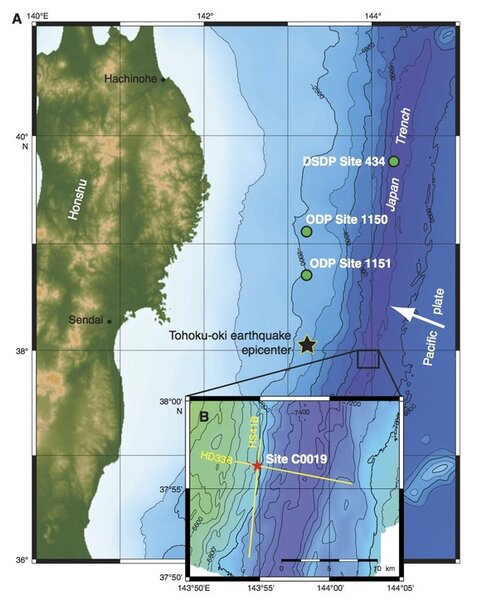Japan's monster quake: Do scientists have key to decode future temblors?
Loading...
Japan's massive 2011 earthquake was lubricated by a thick layer of nearly frictionless clay, according to a series of articles in the current issue of Science. The clay itself has been thoroughly described, but it's the other piece – the friction measurements – that may have broader implications for the future of earthquake physics.
"The main storyline is that the rupture occurred, to a great extent, because of the weak clay, but there's more to it than that," says Frederick Chester, a tectonophysicist at Texas A&M University, and lead author of one of the Science papers.
"The clay is cool, the clay is important, but it's the not big breakthrough," agrees Emily Brodsky, an earthquake expert at the University of California, Santa Cruz (UCSC). "The big breakthrough is that this was the first-ever measurement of friction during an earthquake."
Geologists know the plate tectonic forces that push on faults, she explains, but the open question in earthquake physics has been the force that resist movement: friction.
Knowing only one direction of force is like trying to design a rocket to fly to the moon without knowing about gravity or air resistance. You can build a big engine, but if your rocket isn't aerodynamic and can't overcome gravity, it won't reach space.
The magnitude 9.0 Tohoku-Oki earthquake that devastated Japan on March 11, 2011, had an epicenter over two thousand feet under the seafloor, and the seafloor is miles below sea level. To study the earthquake, a team of scientists and engineers had to confront a truly extraordinary logistical challenge: drilling three separate holes, all more than half a mile long, in some of the deepest water on the planet.
"The engineering challenges of this project were enormous," says Dr. Brodsky. "We were operating under 7 kilometers (4.5 miles) of water. Nobody had ever drilled a substantive hole at this depth before." For comparison, Deepwater Horizon, which made headlines for its deep-water drilling project in the Gulf of Mexico even before the colossal oil spill, was operating under one mile of water. This was more than four times as deep, and many times more complicated.
"It was a technological tour de force," says Casey Moore, an emeritus geology professor at UCSC and a coauthor on the paper.
"A lot of new technology had to be developed for this," says Brodsky. Some of the new, untested equipment failed in the early weeks of the expedition, says Dr. Chester.
"Over the first month or so, we didn't have any successful science accomplishments," says Chester, but after some on-board re-engineering, they succeeded in accomplishing all of the expedition's science goals during the second month of the ocean voyage.
"What's the reason we invested so much time, effort, and resources into this project?" asks Brodsky rhetorically. "We can't do earthquake physics unless we know the friction, and now we have the first-ever measure of friction in an earthquake."
How did they do it?
"The fact is, whenever you slide two things past each other, they generate heat. So one way to measure the friction is temperature," she explains. When you rub your hands together, they get warmer, so theoretically you could calculate your hands' friction by measuring their temperature – "if you're geeky enough," Brodsky adds with a laugh.
To measure the friction within the Tohoku-Oki earthquake, the researchers strung 55 temperature gauges down a half-mile long borehole. Most of the thermometers were in the overriding Eurasian Plate, but some reached into the fault itself and even below, into the subducting Pacific Ocean Plate. They were placed 16 months after the earthquake, and they gathered temperature records for the next nine months. Though it sounds like a long time after the earthquake, Brodsky says, it's quick enough, geologically speaking, that the rocks would still hold the heat of their sliding.
When they recovered the thermometers nine months later, the scientists were surprised to find how little heat the fault had recorded – only about a third of a degree more than the background temperature.
That's why scientists hadn't succeeded in measuring frictional heating in other earthquakes, says Brodsky: Earthquakes produce much, much less friction than the models predict. It's only because this earthquake was so remarkably large – magnitude 9.0, displacing a huge section of the seafloor by more than 150 feet – that it generated enough heat to measure at all.
"Now that we know what we're looking for," says Brodsky, "we know how to instrument it correctly on land," and gather friction heating measurements from other, more accessible faults.
What did they find?
The coefficient of friction on the slip surface of this fault was about 0.08, which is comparable to the friction of tires on ice. For comparison, "other clays have a coefficient of 0.2 or 0.4, and basalt (which makes up the underlying layers) is 0.6," says Dr. Moore.
So why was this particular layer of clay so weak? It's made of 130-million-year-old seafloor mud, called "smectite," initially deposited in the center of the ocean and transported to the Japanese coastline by the ongoing subduction of the Pacific Plate under Asia, says Moore.
"The smectite accumulated in the center part of the Pacific Ocean. Nothing gets there but very fine, wind-rafted material. If anything dies out there, it gets dissolved (before it reaches the seafloor)," he says. "It's the oceanic equivalent of a desert." In that wasteland, mud accumulates slowly – very slowly. These "very, very fine-grained sediments" took 80 million years to reach their measured thickness of 60 feet deep, says Moore.
The samples gathered from the boreholes are still being studied in labs around the world, says Texas A&M's Chester, to better understand the clay itself as well as the physics behind its role in lubricating the earthquake's slip.
"These discoveries answered some really fundamental questions by confirming, at least in this one case, the low strength of faults while they're slipping seismically – something the community has been coming to realize for the past 10 or 15 years through theoretical and experimental work. To document it so clearly, in-situ, by drilling into this fault zone – that's the most exciting scientific result: real, direct observation of nature confirming some of our hypotheses so clearly.
Researchers are planning future missions to the northern Pacific, where this clay layer is subducting under Russia's Kamchatka and Alaska's Aleutian islands, says Moore. That area has "a lot of huge earthquakes, most of which produce tsunami," he says. "It behooves us to look around the world and say, OK, can we tie this (smectite clay) to other tsunami earthquakes?"








